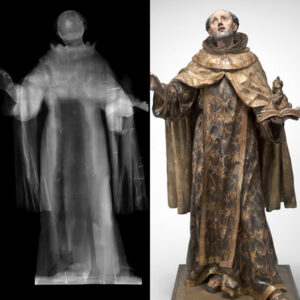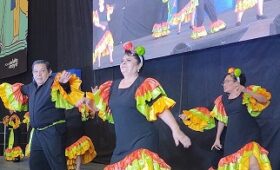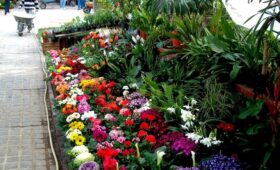A type of art seen all over town called painted wood, or polychrome, statues have entered the world stage as desired collectibles in museums and private collections. Why? What does that mean to the art scene in San Miguel de Allende?
Up until the 16th century wood, terracotta and alabaster were typical sculpture mediums here in Mexico, but that all changed in the 17th century as Spain championed creating painted wood sculptures.
 One artist sculptured the wood into a Virgin, Saint of Jesus. Then a painter came along and painted on top of the wood. Before that wood statues would often be gold leafed for color and visual appeal. Now the image had flesh toned skin, ivory teeth, glass eyes, resin tears, real hair wigs and eyelashes – all of which added to the realism of the piece.
One artist sculptured the wood into a Virgin, Saint of Jesus. Then a painter came along and painted on top of the wood. Before that wood statues would often be gold leafed for color and visual appeal. Now the image had flesh toned skin, ivory teeth, glass eyes, resin tears, real hair wigs and eyelashes – all of which added to the realism of the piece.
Sidebar: If you are a big fan of the earlier gold leaf sculptures you’ll really enjoy the altars and side sculptures in the Temple of the Immaculate Conception and Temple of Good Health!
Regulations attempted to exclude the indigenous artists from working in painted wood sculpture specialties though evidence shows that such rules were widely disregarded.
Painted wood sculptures were intended for display in monasteries, convents and private chapels. Frequently placed under glass domes they allowed the viewer to get very close to the art deepening ones’ faith for inspiring prayer and meditation by drawing the viewer in. The sculptures were never intended to be appreciated as art objects in and of themselves, though they are now.
Sculptures are more tactile than paintings as the bodies of work take up space just like our physical bodies do. Such vivid and realistic depictions of the subject’s sufferings or joys created empathy and emotional viewer reactions.
These emotional viewer responses also created discomfort and why they had been largely ignored in museums and the canons of art history. Painted wood sculptures challenge our visual culture and what we presume to be high art.
Painted wood sculptures excel at expressing extraordinary grief and are part of the treasure trove of art in San Miguel de Allende’s Holy Week processions. The Baroque hyper-realistic sculptures aid in understanding the sadness of Holy Week leaving a lasting impression on all viewers.
For example, at one point on Good Friday’s procession Jesus crosses paths with his mother. Embarrassed to be seen by her as prisoner an ancient pulley system allows him to bow his head to look away. As someone carrying his statue I can vouch it still gives ‘ohhs’ and ‘ahhs’ among the crowds watching.
 In Spain clothing was carved separately out of wood and added on to the statue like a puzzle shown in the graphic and x-ray. In San Miguel de Allende the cloistered nuns from the Immaculate Conception church raised money by making garments so images of Mary, Jesus and saints often feature actual cloth instead.
In Spain clothing was carved separately out of wood and added on to the statue like a puzzle shown in the graphic and x-ray. In San Miguel de Allende the cloistered nuns from the Immaculate Conception church raised money by making garments so images of Mary, Jesus and saints often feature actual cloth instead.
 Prior to painted wood sculptures typically it had been the white marble statues that were the art to be admired and studied, think early Greek and Roman images. In marble, however, the human body is at an ideal, considered too perfect to even be real like the image of David or the Pieta. Hence, as devotional images the viewer is rather removed unlike painted wood art that pulls the viewer in to share the experience of mourning, being crucified and so on.
Prior to painted wood sculptures typically it had been the white marble statues that were the art to be admired and studied, think early Greek and Roman images. In marble, however, the human body is at an ideal, considered too perfect to even be real like the image of David or the Pieta. Hence, as devotional images the viewer is rather removed unlike painted wood art that pulls the viewer in to share the experience of mourning, being crucified and so on.
The next time you are in a San Miguel de Allende church or antique store look around for painted wood sculptures. Even if you believe in none of the Catholic faith, the art’s ability to place you, personally, in the time and place depicted is extraordinary!



